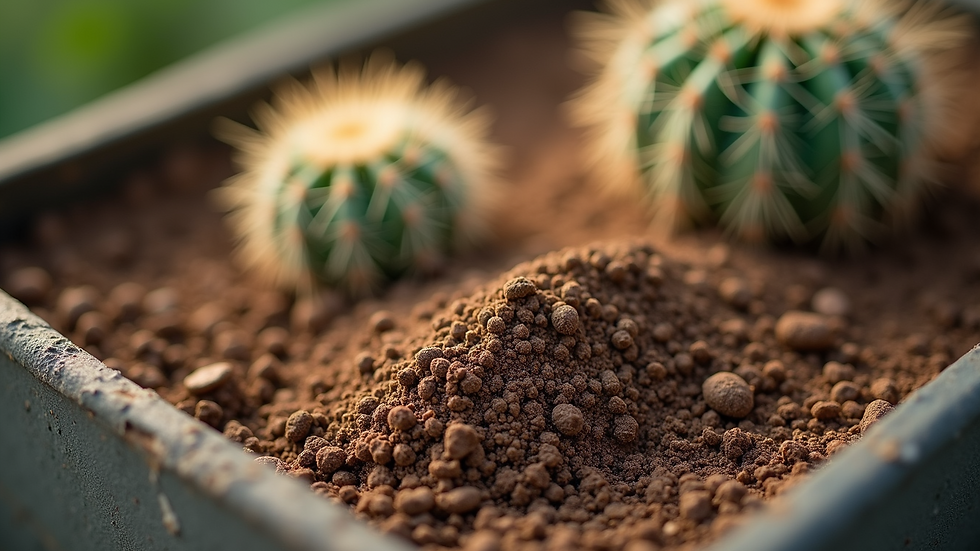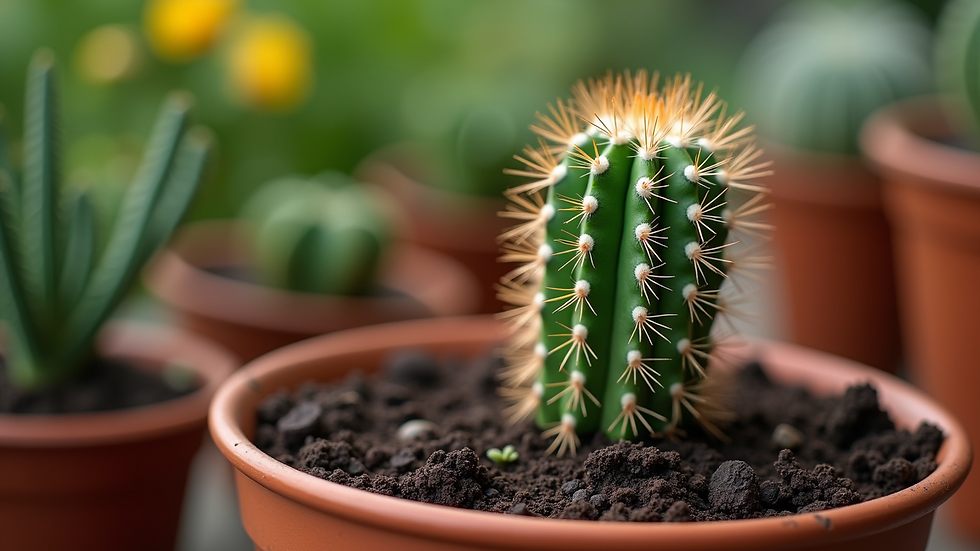Choosing the Best Soil for Healthy Cactus Growth
- Ali

- Aug 4
- 3 min read
Cacti are fascinating plants that thrive in dry, arid environments. Their unique ability to store water makes them perfect for indoor gardening and xeriscaping. However, to keep your cactus healthy and growing strong, choosing the right soil is crucial. The soil you use affects water drainage, root health, and nutrient availability. This guide will walk you through everything you need to know about selecting the best soil for your cactus, ensuring vibrant growth and longevity.
Understanding Cactus Care: Why Soil Matters
Cactus care involves more than just watering and sunlight. The soil plays a vital role in mimicking the cactus’s natural habitat. Unlike many other plants, cacti require soil that drains quickly to prevent root rot. Heavy, moisture-retentive soils can suffocate roots and cause fungal infections.
Cacti naturally grow in sandy, rocky soils with minimal organic matter. This environment allows water to pass through rapidly, preventing excess moisture buildup. When caring for cacti, replicating these conditions is essential. Using the wrong soil can lead to poor growth, yellowing, or even death of your plant.
Key factors to consider in cactus soil:
Drainage: Soil must allow water to flow through quickly.
Aeration: Roots need air to breathe and grow.
Nutrient content: Soil should have enough nutrients but not be overly rich.
pH level: Slightly acidic to neutral pH is ideal.
By understanding these factors, you can provide the best environment for your cactus to thrive.

Close-up view of a healthy cactus planted in well-draining soil
Key Components of Ideal Cactus Soil
Creating or choosing the right soil mix for your cactus involves combining materials that promote drainage and aeration. Here are the main components to look for or include:
Coarse Sand or Grit
This improves drainage and prevents soil compaction. Avoid fine sand, which can hold too much water.
Perlite or Pumice
These lightweight volcanic materials increase aeration and help retain some moisture without waterlogging.
Organic Matter
A small amount of compost or peat moss provides nutrients but should be limited to avoid excess moisture retention.
Potting Soil Base
Use a light, well-draining potting mix as the base. Avoid heavy garden soils.
A typical cactus soil mix might be:
50% coarse sand or grit
25% perlite or pumice
25% potting soil with minimal organic matter
This blend ensures water drains quickly while still providing enough nutrients for growth.

Eye-level view of a container filled with a cactus soil mix
What soil should I plant my cactus in?
When selecting soil for your cactus, it’s best to use a specialized cactus or succulent mix available at garden centres. These mixes are formulated to meet the drainage and nutrient needs of cacti. However, if you prefer to make your own, follow the guidelines above.
Avoid using regular potting soil alone, as it retains too much moisture. Also, steer clear of garden soil, which can be dense and poorly draining.
If you want to enhance your soil further, consider adding:
Charcoal: Helps absorb toxins and improves drainage.
Small gravel or crushed rocks: Adds texture and prevents soil compaction.
When potting your cactus, ensure the container has drainage holes. This allows excess water to escape, preventing root rot.
For more detailed advice on soil for cacti plants, check out this helpful resource.

High angle view of a cactus being planted in a pot with proper soil
Tips for Maintaining Healthy Cactus Soil
Once you have the right soil, maintaining it is equally important. Here are some practical tips:
Water sparingly: Only water when the soil is completely dry.
Repot every 2-3 years: Refresh the soil to prevent nutrient depletion and compaction.
Avoid over-fertilising: Use a diluted cactus fertilizer during the growing season.
Check for pests: Soil can sometimes harbour pests like fungus gnats; treat promptly if noticed.
Use pots with drainage: Always ensure your cactus is in a pot that allows water to drain freely.
By following these tips, you can keep your cactus soil healthy and your plant thriving.
Signs Your Cactus Soil Needs Attention
Knowing when to change or amend your cactus soil is key to ongoing plant health. Watch for these signs:
Water pooling on the surface: Indicates poor drainage.
Soft or mushy cactus base: A sign of root rot from excess moisture.
Slow or stunted growth: Could mean nutrient deficiency or compacted soil.
Foul smell from soil: Suggests fungal or bacterial growth.
If you notice any of these, it’s time to repot your cactus with fresh, well-draining soil.
Choosing the best soil for your cactus is a simple yet vital step in cactus care. With the right soil mix, proper watering, and regular maintenance, your cactus will flourish and add beauty to your space for years to come. Remember, the foundation of healthy cactus growth starts beneath the surface with the perfect soil.






























Comments